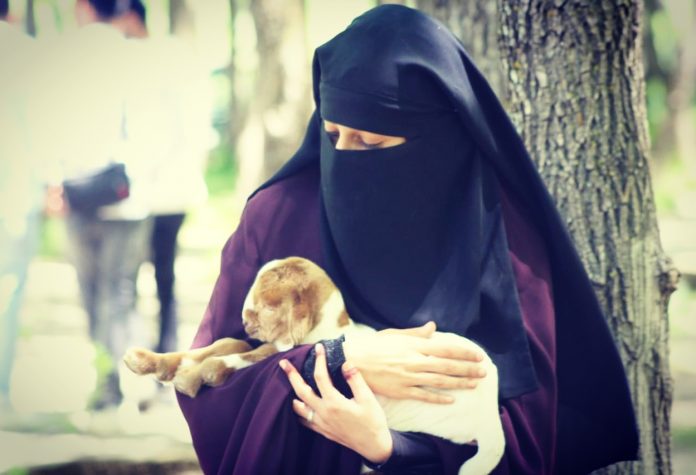Coming from a middle-class family of Baghat Barzulla, Srinagar, an electronics and communication graduate from Kashmir University has taken up a creative pursuit to challenge certain plaguing notions and biases existing in the society.
At 24, Sumayya Magray aka Sana, has already become quite a name for her beautiful henna art and patterns. In virtual world, they know her as @mehandibysana and hail her as ‘the first female organic henna artist from Kashmir’.
Sana makes her motives clear when quizzed over her career choice. “My main objective is to eliminate the stereotype given to the female henna artists—otherwise looked down upon as ‘Maenzi Wajen’,” she says.
In a candid chat with The Indus Post’s correspondent Irtika Manzoor, the young henna artist talks about her cherished art, its scope and the need to rise above certain plaguing societal perceptions.
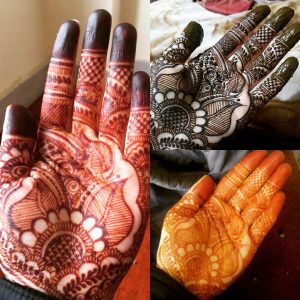
How did your journey as a henna artist begin?
I was drawn into the designs ever since I started making sense of the world around me. I loved to have henna designs done on my hands. But the moment of reckoning came when I was in Class 5 and went to attend one of my friend’s cousins wedding ceremony.
There, a male henna artist, a non-local drew a pot with flowers on my hand. I felt it ugly—because I had the sense of henna designs.
So when I came back home, I started making henna designs on my hand by myself. Then, from my Class 7, I began making henna designs on the hands of brides. After that I was well-sought-after among my relatives for my decorative art. It never stopped—until it became a career choice for me.
Passion becoming profession is still quite a rarity in our part of the world. How did you manage to blur the line between the two?
In my third semester, at Kashmir University, I got in touch with an Instragramer named @mehandibyhayat, a Kashmiri henna artist living outside the valley. Her works greatly inspired me.
I contacted her and shared my henna designs with her. She appreciated my works and whole-heartedly helped me and suggested me to make my own Instagram page and start uploading my designs.
It was totally new experience for me. I asked my cousin to make my page and he renamed his own page (@Paradisekashmir) with @mehandibysana.
Then in 2017, I started making cones myself but the results were not good. I talked to @mehandibyhayat about it. She made me avail organic henna powder and oil.
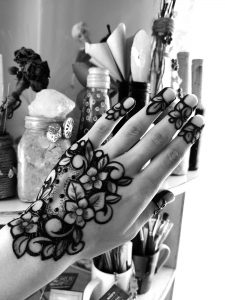
So, that’s how you became Kashmir’s first organic henna artist?
Yes, you can so. When Kashmir was still oblivious of organic henna, I made my first batch of organic henna cones. And I was amazed with the results. As compared to chemical henna, the organic henna stood out in purity, colour and neatness.
Then I made design on my friend’s hand with that first batch of henna cones. I uploaded the pictures and I was given a shout out by @mehandibyhayat with the caption: “First Kashmiri Organic Henna Artist”.
And all of a sudden, I got 2k followers in place of 70. This is how my journey as an organic henna artist started.
But despite the fact how serious-minded Kashmiri youngsters—like you—now increasingly take up such creative career choices, why people still look down upon henna artists especially females?
I feel it is the non-local male henna artists who are responsible for degrading the essence of henna art in people’s eyes.
I’ve seen them coming to weddings and start talking—as if this is their “bread and butter”. They put so much stress on the word ‘mazdoori’ that people start looking them as ‘mazdoors’, instead of artists.
No doubt this might be their only source of earnings, but this is an art form and it needs to be respected. According to me, this thing gave stereotype to henna artists.
While working towards that, did you yourself ever face any kind of bad experience?
Not so often, but I feel bad the way people think of us. They do ask some kinds of ridiculous questions. I think, people should respect the fact that if somebody is working for them, he or she isn’t their servant. We should learn to respect others.
That said, Sana, many would still ask: why would people prefer you over other henna artists in town?
First of all, I’m an organic henna artist. My henna is far better than chemical henna cones. It gives the long lasting stain to hands, beautiful colour, and moreover, it is a pure paste without any side-effects. It is not harmful in any way. Every girl should prefer organic henna over the chemical henna.
Secondly, I think you’ll never find those henna artists as professionals. They randomly draw a design on hands, as a matter of routine, without discussing their designs with their clients.
But, I always make it sure to discuss designs properly. I ask girls about what kind of design they want and everything. I always want to make something standard and I believe if you want to make something standard, make it through your professionalism.
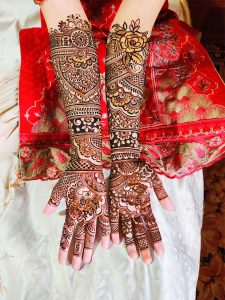
You said non-locals mainly do it for ‘mazdoori’ than art, but when it boils down to reality, how much affordable you make your art for people?
I always take into consideration how the business of other people is running. In Srinagar, the best henna artist named Pramod charges Rs. 5500 for basic bridal henna designs. His staff uses chemical made cones only. The raw material used in making such (chemical) cones is very cheap as compare to the raw material used for making organic cones.
Moreover, their designs are thick, but mine are thin and intricate. So, taking all these things into consideration, I charge Rs. 6500 for basic bridal design just to maintain the gap in between. And then the charge depends upon time, designs and length also.
Of course, at the end of the day, I’m putting all of my efforts and creativity into it, so I’ve to charge equally.
Alright. Since you said how you used Instagram page for your brand promotion. Now, when internet is down in your homeland, how do you stay in touch with your clients?
You’re right. Instagram was my window to connect with my clients.
When I started in 2017, I took bookings through my Instagram handle only. Later, with the help of a friend, I came up with my own website. After proper design discussions, I would take most of my work orders through my website.
And then, unfortunately, 2019 happened. And internet blockage spoiled everything.
So, do you work alone, or with a team?
I’m a one-woman army here. I, from making cones to designing, do everything by myself. I tried to make a team but I never find people as enthusiastic as me—which, in Kashmir, is an issue.
I understand my art but people don’t. I feel that people don’t value someone’s art by heart. But I have Nazr-ul-Islam and one more friend of mine who handles my website and Instagram handle.
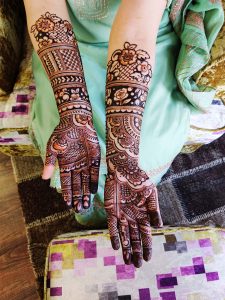
What other ways are you using to promote your art?
There is a festival called Sonzal organized in Kashmir University every year. In 2019, by the grace of Allah, they organized mehandi competition. I took part there and bagged first position and people over there appreciated me very much.
After that, I was selected for North-India nationals. I didn’t get any position there because of unrelated theme of my designs, but I was appreciated.
That appreciation boosted my confidence. And then I got the idea of organizing an event called Maenz competition cum workshop at Jhelum Café in April 2019. The event was attended by many well-known women guests. I was highly appreciated. I got to know about many other girls who too are interested in henna art, but lacked proper resources and guidance.
Now when you have come this far in life with your art, how do you see your future?
I have a dream of setting up a mehandi studio for Kashmiri girls so that I can guide them to this ‘halal’ way of earning. I also want to make people aware of organic henna, so that they will always prefer purity over harmful chemicals.
I also want to make people respect this form of art—as we are not ‘mehandi waliya’, rather mehandi artists.


